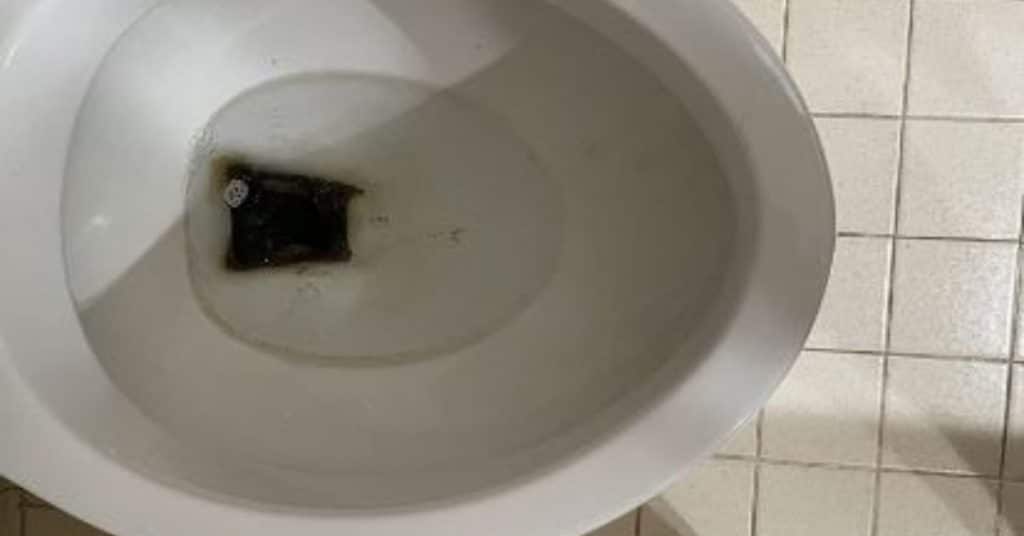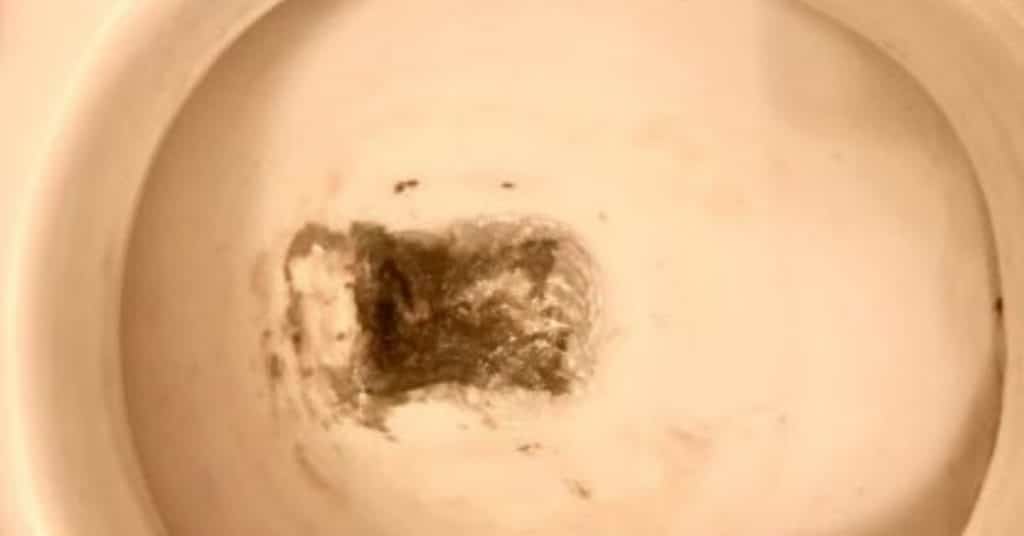Black Stains in a Toilet Bowl? Why & How to Remove them
Last Updated on October 4, 2023 by toilethaven
What Causes Black Stains in a Toilet Bowl?
Unlike in the 1900s when toilets used to be colorful, today’s toilets are all white, making cleaning them difficult. It is also very easy to spot any stain on the toilet, especially black stains in a toilet bowl.
Black stains/spots in a toilet bowl are caused by mold or mineral deposits, especially manganese. If the stains appear above the waterline, you most likely have black mold, while manganese deposits usually cause black spots under the bowl’s waterline.

To remove black stains from a toilet bowl, start by soaking up the water at the bottom of the bowl using a cloth. Prepare a vinegar and borax or baking soda paste and apply it all over the stains. Wait for about 30 minutes and scrub off the stains using a toilet brush.
Although you can use other products like bleach and muriatic acid to remove black spots from a toilet bowl, baking soda/borax and vinegar are less toxic and gentler on your plumbing. Bleach or acid will also kill the good microbes if you are on a septic system.
Mold vs. Manganese Black Spots in a Toilet Bowl
Mold spores are always present in our homes. However, they thrive in dark, warm, damp surfaces like the toilet bowl or inside the toilet tank. Apart from black, mold can also be green, grey, orange, purple, pink, or even red.
To prevent mold from growing in your toilet bowl or other fixtures, clean them regularly using baking soda and vinegar. The vinegar penetrates through surfaces, thereby killing their roots.
Since molds need oxygen to grow, they will be found above the toilet bowl’s waterline, with ample air supply. Constant toilet flushing supplies them with the moisture they need to thrive.
Living in an area with hard water will manifest in your fixtures like toilets, tubs, and sinks. The minerals found in hard water in large concentrations are iron, manganese, and calcium.
Iron forms reddish brown spots in a toilet bowl and, in most cases, a red ring around the waterline called a toilet ring. Calcium (also known as a limescale) forms a whitish or creamy accumulation in the bowl.
Installing a water softener is the best way to get rid of hard water stains in toilets and other fixtures. A water softener removes the hard water minerals before the water enters your house, preventing the clogging of pipes and appliances.
Removing manganese (like iron) in your water is challenging, even when you have a water softener, depending on its oxidation state, water pH, and other dissolved minerals. You can, however, install a reverse-osmosis unit to further remove the manganese.
Another option for removing manganese from water before it stains your toilets and other fixtures is installing an iron filter. This is because manganese and iron are almost chemically identical, hence the same removal process.
How to Remove Black Spots from a Toilet Bowl

And now, let us look at how to remove black spots from a toilet bowl in more detail. You will need the following items for this job:
- Borax or baking soda
- Vinegar
- Toilet brush
- Hydrogen peroxide
- Cream of tartar
- Cloth
- Nylon gloves
- Old toilet brush
First, you should determine whether the black stains in the toilet bowl are caused by manganese deposits or mold. As I had mentioned earlier, black spots above the waterline are usually mold spots, while manganese stains cause a black deposit under the waterline.
If you are not sure whether the black spots are caused by manganese or mold, always treat it as if it were mold. Let us now look at how to remove black spots in a toilet, starting with mold spots.
How to Remove Black Mold Spots from a Toilet Bowl
- Start by removing the water at the bottom of the toilet. You can try to force as much of it down the drainpipe using a toilet plunger, then soak up the remaining little water using a cloth.
- Pour ½ cup borax at the bottom of the bowl. Borax is legal in the United States but banned in Europe. It is more potent than baking soda, so use one whole cup if you have to use baking soda.
- Slowly add 2 cups of vinegar inside the bowl. I insist on slowly adding the vinegar since it reacts quickly with the borax/baking soda.
- Use a toilet brush to swish the solution around the toilet bowl (not forgetting under the rim of the toilet) until every part of the bowl is wet/saturated with the solution.
- Keep swishing the solution around the bowl after every 15 minutes for an hour or 2.
- Use the toilet brush to scrub the toilet bowl, focusing more on the black spots until they are completely gone.
- Flush the toilet to rinse the bowl.
- Clean the toilet bowl using baking soda and baking soda at least twice a month to prevent the black mold from recurring.
How to Remove Black Manganese Spots from a Toilet Bowl
- Start by turning off the water to the toilet. The shut-off valve is on the wall behind the toilet. Turn the handle/knob clockwise.
- Flush the toilet. The reason behind turning off water to the toilet is to prevent water from flowing from the tank to the bowl during refilling. This will lower the water level at the bottom of the bowl.
- Alternatively, using a cloth, you can completely soak up the water at the bottom of the bowl. Make sure you have your nylon gloves on.
- Mix the cream of tartar and 3% hydrogen peroxide until you form a past with a good consistency. The quantity of paste to prepare depends on the magnitude of the stains.

- Use an old toilet brush to apply the paste on the black spots. Again, keenly check underneath the toilet bowl rim as manganese spots can also form there, where the water exits the tank and enters the bowl.
- Wait for about 30 minutes.
- Use a toilet brush to scrub off the stains until they are all gone.
- Turn on the water supply to the toilet tank and let the tank fill.
- Flush the toilet to rinse the bowl.
- Check if all the black spots are removed.
- If a few black spots remain on the bowl, prepare another paste and repeat the process.
And basically, that is how to remove black stains/spots from a toilet bowl. If you do not have the cream of tartar and/or hydrogen peroxide, you can also use a borax and vinegar paste.
Remember that this method removes the black stains but does not prevent them from recurring. If the water flowing to your house is rich in manganese, you will always have black stains in your toilet bowl and other fixtures.
Hard water mineral deposits also cause premature failure of appliances like dishwashers and washing machines. Installing a water softener is a better and long-term solution to this problem, but is a bit expensive.